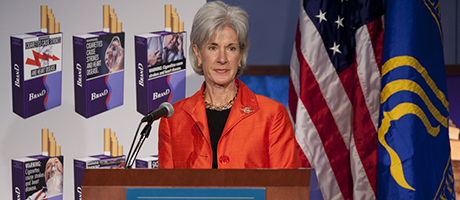By Jennifer Eder
Beginning in 2012, tobacco companies will be required to display new graphic health warnings on both cigarette packages and advertisements.
The U.S. Department of Health and Human Services unveiled a new comprehensive tobacco control strategy, which includes the bolder health warnings, Wednesday at the George Washington University’s Jack Morton Auditorium.
“Every day, almost 4,000 youth try a cigarette for the first time, and 1,000 youth become regular daily smokers,” said HHS Secretary Kathleen Sebelius. “Today marks an important milestone in protecting our children and the health of the American public.”
According to HHS, tobacco use is the leading cause of premature and preventable death in the U.S. – responsible for 443,000 deaths each year. Thirty percent of all cancer deaths are due to tobacco, and every day, 1,200 people die from tobacco-related diseases.
Over the past 40 years, tobacco use has reduced dramatically, but in recent years the decline has stalled. About 20.6 percent of adults and 19.5 percent of high school students currently smoke cigarettes.
As part of the new HHS tobacco control strategy, the Food and Drug Administration has proposed requiring cigarette companies to display nine new warning statements on cigarette packages and cigarette advertisements. These warning statements are not only larger and contain more noticeable text, but they also include color graphic images depicting the negative health consequences of smoking, such as dead bodies, a tombstone, a dying patient and a black lung.
These images are paired with messages such as “Cigarettes cause fatal lung disease,” “Cigarettes cause cancer,” “Smoking can kill you” and “Tobacco smoke can harm your children.” The images must cover at least 50 percent of every pack of cigarettes and 20 percent of every advertisement.
“Today, FDA takes a crucial step toward reducing the tremendous toll of illness and death caused by tobacco use by proposing to dramatically change how cigarette packages and advertising look in this country,” said FDA Commissioner Margaret A. Hamburg. “We want to make sure every person who picks up a pack of cigarettes knows exactly the risk they’re taking.”
The public has an opportunity to comment on 36 proposed images through Jan. 9, 2011. By June 22, 2011, the FDA will select the final nine graphic warning statements, and starting in September 2012 cigarette companies will be required to display the new health warnings on cigarette packages and advertisements.
“Although there already is a warning on cigarette packs, it’s on the side of the box. There’s boring black and white text, and it’s easy to ignore,” says Lynn Goldman, dean of GW’s School of Public Health and Health Services. “I think these new warnings will have an effect on particularly young people, who are thinking about starting to smoke.”
Doug Evans, a SPHHS professor and director of the Public Health Communication and Marketing Program, said the graphic images are an important step forward but may not be a cure-all.
“The addictive nature of nicotine may impact the effectiveness of these messages, and cigarette companies may find ways to blunt the fear appeal with various packaging and display gimmicks,” said Dr. Evans. “More research is needed on the marketing impact and long-term behavioral effects of the new images on quitting smoking and deterring new smokers.”
As part of its Healthy People 2020 campaign – a 10-year national plan for promoting health and preventing disease in the U.S., HHS has set a goal of reducing U.S. tobacco use by 8 percent by 2020.
“We are at an unprecedented time in our nation’s history to protect the public’s health from tobacco use,” says Assistant Secretary for Health Howard K. Koh. “It will take renewed commitment from every sector of society to end the tobacco epidemic.”


